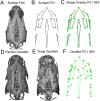Cranial asymmetry arises later in the life history of the blind Mexican cavefish, Astyanax mexicanus
- PMID: 28486546
- PMCID: PMC5423691
- DOI: 10.1371/journal.pone.0177419
Cranial asymmetry arises later in the life history of the blind Mexican cavefish, Astyanax mexicanus
Abstract
As a consequence of adaptation to the cave environment, the blind Mexican cavefish, Astyanax mexicanus, has evolved several cranial aberrations including changes to bone sizes, shapes and presence of numerous lateral asymmetries. Prior studies of cranial asymmetry in cavefish focused strictly on adult specimens. Thus, the extent to which these asymmetries emerge in adulthood, or earlier in the life history of cavefish, was unknown. We performed a geometric morphometric analysis of shape variation in the chondrocranium and osteocranium across life history in two distinct cavefish populations and surface-dwelling fish. The cartilaginous skull in juveniles was bilaterally symmetric and chondrocranial shape was conserved in all three populations. In contrast, bony skull shapes segregated into significantly distinct groups in adults. Cavefish demonstrated significant asymmetry for the bones surrounding the collapsed eye orbit, and the opercle bone posterior to the eye orbit. Interestingly, we discovered that cavefish also exhibit directional "bends" in skull shape, almost always biased to the left. In sum, this work reveals that asymmetric craniofacial aberrations emerge later in the cavefish life history. These abnormalities may mirror asymmetries in the lateral line sensory system, reflect a 'handedness' in cavefish swimming behavior, or evolve through neutral processes.
Conflict of interest statement
Figures





References
-
- Finnerty JR. The origins of axial patterning in the metazoa: how old is bilateral symmetry? Int J Dev Biol. 2003; 47:523–529. - PubMed
-
- Grammer K, Thornhill R.Human (Homo sapiens) facial attractiveness and sexual selection: the role of symmetry and averageness. J Comp Psy. 1994; 108:233–242. - PubMed
-
- Møller AP. Sexual selection in the barn swallow (Hirundo rustica). IV. Patterns of fluctuating asymmetry and selection against asymmetry. Evolution. 1994; 48:658–670. - PubMed
MeSH terms
Grants and funding
LinkOut - more resources
Full Text Sources
Other Literature Sources
Research Materials

